D
Dave Coster
Guest
PURE DYNAMITE
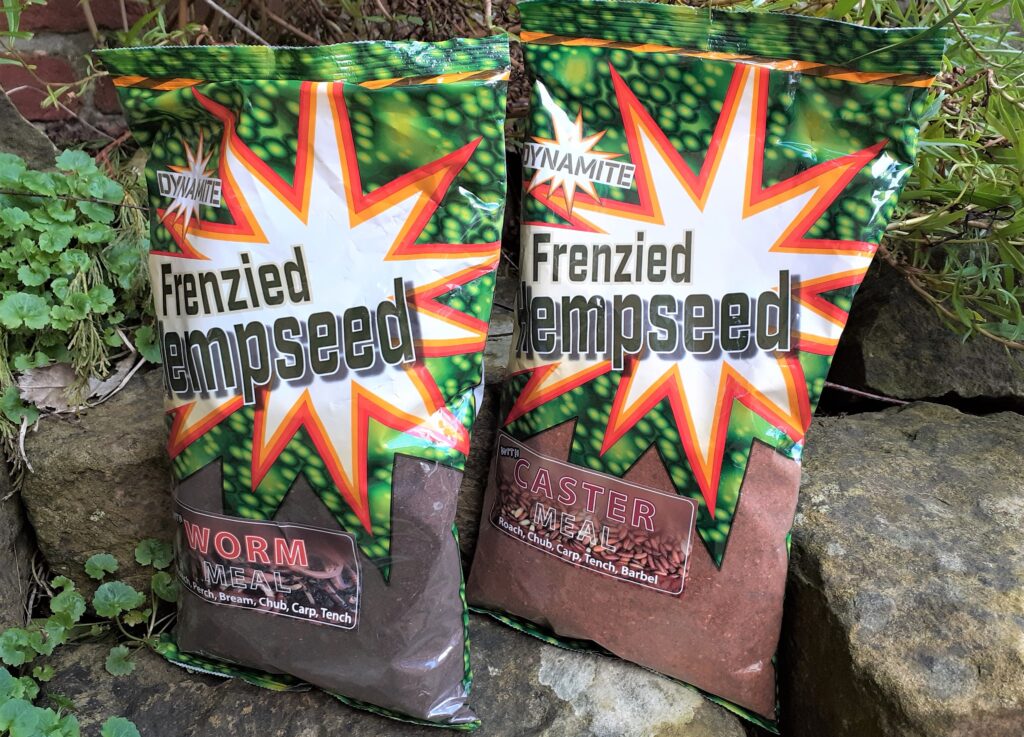
Dynamite is famous for its Frenzied range, which is built around ready-cooked hemp supplied in tins, along with the seeds in crushed form. Both are vital ingredients for many angler’s feeding requirements. Recent additions have seen worm and caster meal groundbaits introduced. They are easy to mix, fine in consistency, and super-rich in proteins and aminos. Due to a high ground hemp content, these are active recipes, mainly aimed at natural venues. The worm version is black, while the caster option is a dark brown colour. Both work extremely well in their own right, but are also good for darkening down and enriching other types of feeds. I’ve used these groundbaits extensively with pole, open-end and cage feeder tackle. They fizz and break down quickly if mixed neat or with crumb, slowing down with stiffer consistency mixes for deep or flowing water work. Explosive graphics on the packaging match the quality contents inside.
CONTINENTAL WAYS
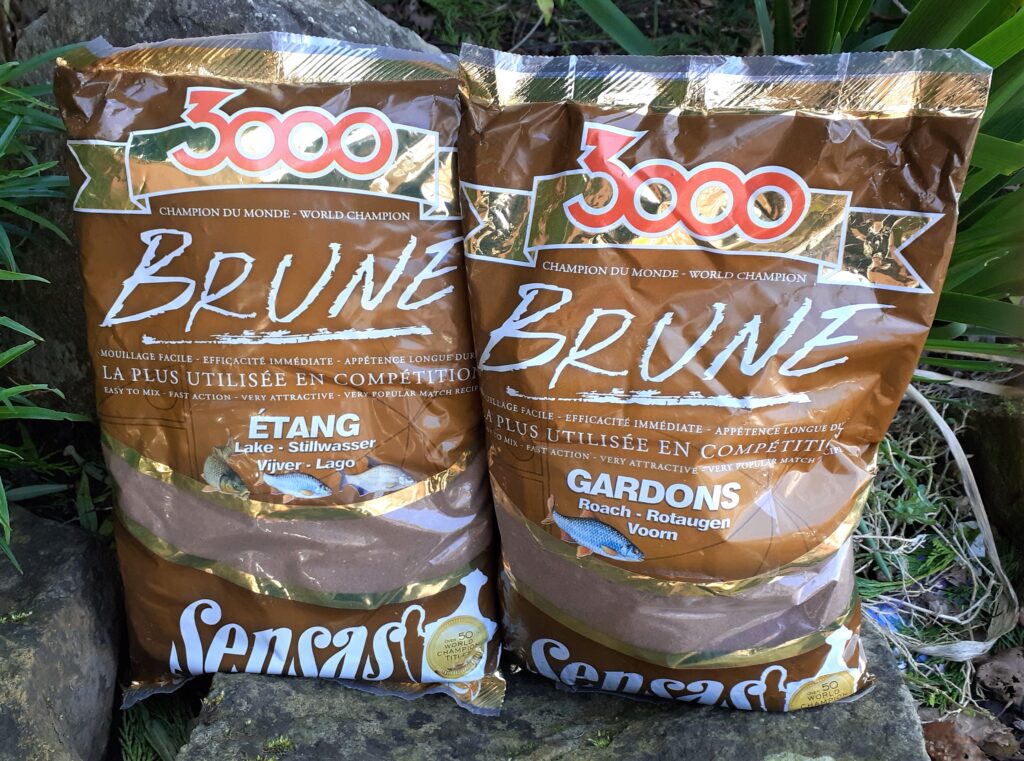
Better groundbait recipes began to catch my attention several decades ago, when Continental mixes started appearing on the shelves in tackle shops. Up to that point groundbait packaging was on the dull side, but suddenly we had a new concept, with much more interesting names and eye-catching artwork. Sensas and Van Den Eynde products quickly became household names, giving us famous recipes like Super Cup, Secret, Turbo, Magic, Lake and Explosive. A new world opened up, where groundbaits were designed for different types of venues, species and methods. The trend continues to this day. I’ve made some good discoveries in the specialist brown range from Sensas. I particularly like Etang and Gardons, which are top silver fish groundbaits, ideal for whip or shallow fishing. You can mix these on the dry side or into a wet slop. They are perfect with some brown crumb added, quickly attracting roach, skimmers, perch, rudd and gudgeon.
GOING GREEN
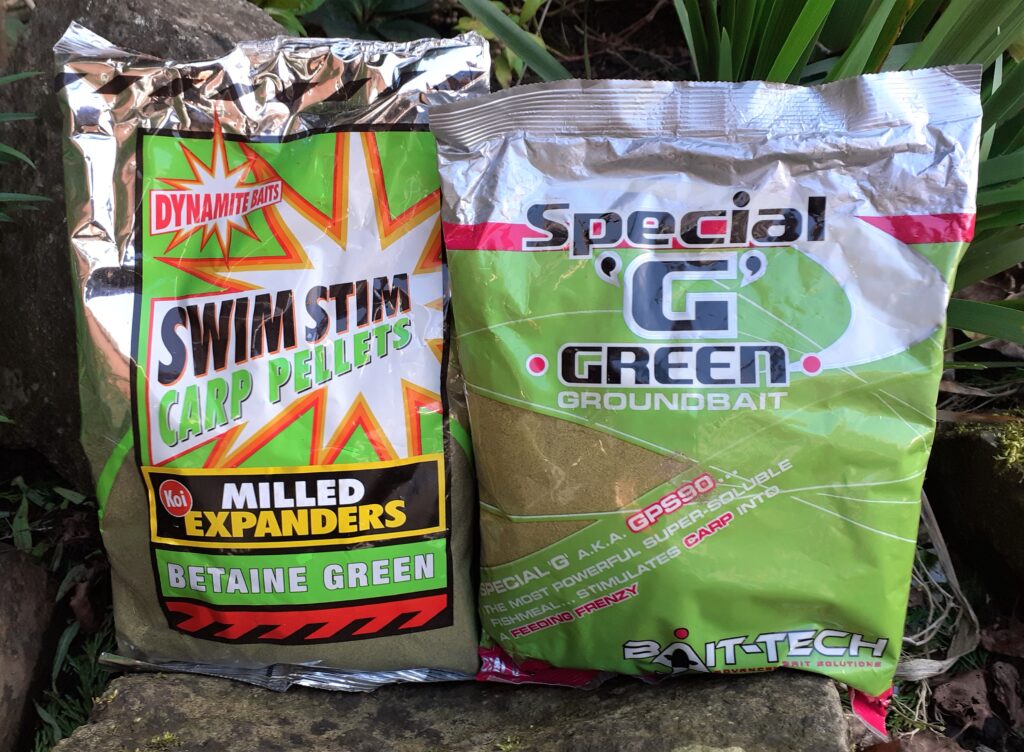
Two mega-popular mixes are Bait-Tech Special “G” Green and Dynamite Betaine Green Milled Expanders. These rich recipes are hard to beat on commercial fisheries for targeting carp, but can’t be ignored when after bream or tench, even on natural venues. Both super-fine consistency feeds pull loads of bites when used as paste on the hook, which proves fish love the ingredients. All you need for a busy session is just one bag of either of these products, using them in roughly wetted form to attract and hold fish, flicking a bit of extra water over the mix to form balls of bait for the hook. I deliberately prepare these groundbaits in a slapdash manner, so they end up lumpy. The groundbait is then fed loose like this, which creates a nice bed of both fine particles and bigger pieces, so fish graze over the feed for long periods. Green is a surprisingly effective colour, particularly in the murky waters of busy, fish-packed venues.
SO NATURAL
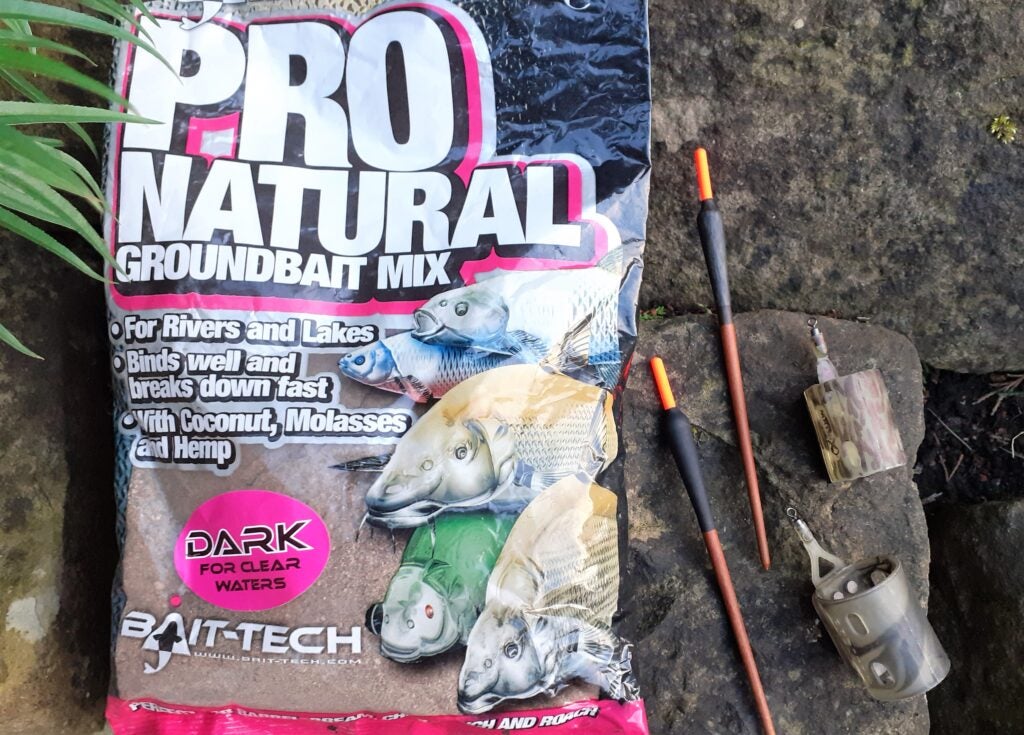
Bait-Tech are masters of classy packaging with their popular groundbaits, none more so than with the Pro Natural range. Stylised images of the types of fish this recipe is designed to catch almost jump out at you from the bag. Rich ingredients like coconut, molasses, nuts and hemp are all in there, combined with a fast break down formula. This dark version is aimed at fishing clear waters and to work as a carrier for baits like maggots, casters, worms, pellets, hemp and sweetcorn. It’s a versatile recipe that can be balled in, catapulted, cupped, or used in various types of feeders. It covers lots of venues, species and methods. I would use this groundbait on waters I don’t know much about, when carefully feeling my way into sessions. A good choice when catapulting small, soft balls over waggler tackle, also for cage feeder and river applications, particularly when using groundbait with float tackle. Makes an excellent winter mix.
TECHNICAL STUFF
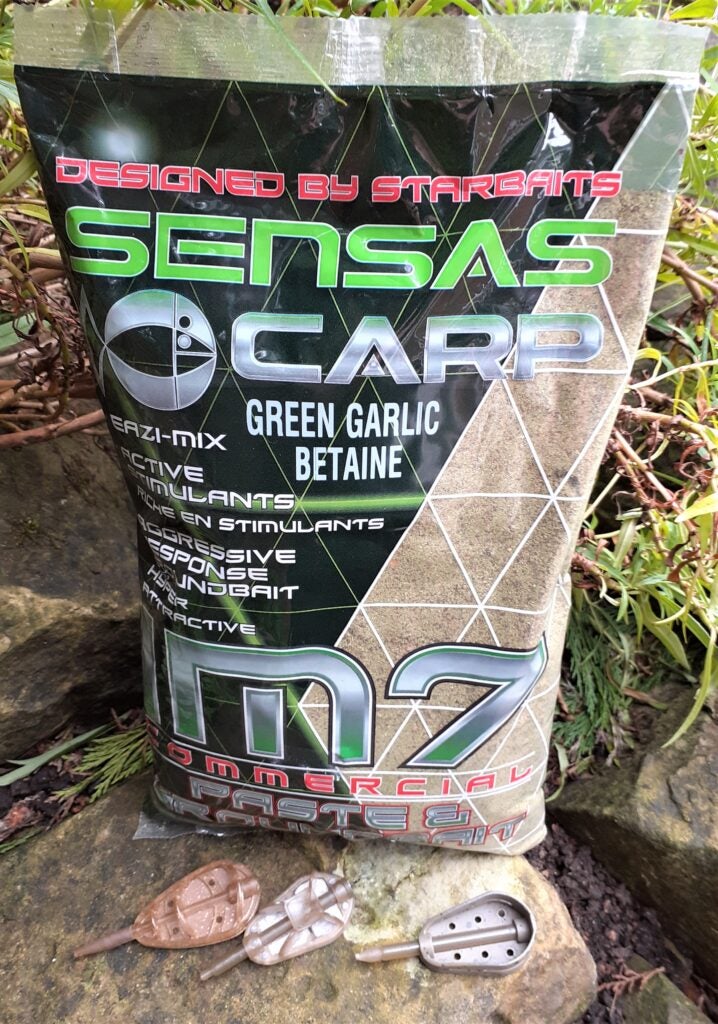
Sensas Carp Garlic Betaine is a green groundbait that wins my award for the most technical-looking packaging. I was also impressed with the description on the back. I quote, “A unique balance of dedicated attraction combined with a high-quality food source that together produce an intense and aggressive feeding response. The high level of water-soluble attractants will create a strong and positive canopy of feed signals that will encourage all fish to search and forage for the food item in a ravenous manner.” That sold the product to me! Along with the super-attractive bag of course! This interesting recipe works as a paste and groundbait for carp, requiring a second dose of water to bind properly. It pulled plenty of action when used with a method feeder, attracting both carp and bream on a mixed fishery. A quick go on a margin pole late on in the session revealed this green, smelly concoction pulls fish in quickly and creates plenty of action.
SPECIAL EFFECTS
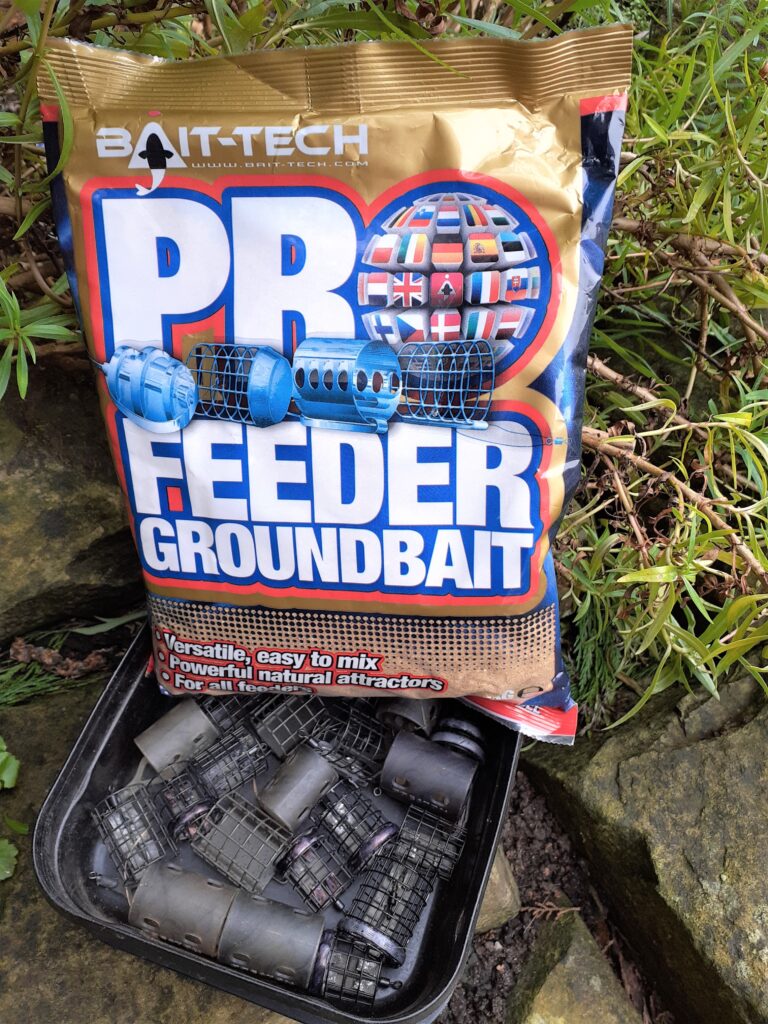
Pro Feeder Groundbait from Bait-Tech stands out from the crowd on tackle shop shelves. Instead of fish images leaping at you, various feeder designs magically hover on the front of the packet. No need to worry about species and venues this gear is suited for; it tells you it will catch just about anything with fins and on all types of venue. My early impressions of this recipe are it can be mixed dry for an explosive consistency, or on the wet side if you want a dead, non-active groundbait. The natural light biscuit-smelling version turns golden brown after wetting, perfect for wild venues, while the dark fishmeal option suits commercial fishery feeder techniques. I was impressed on both fronts. As we all know, sweet groundbaits tend to work better on wild venues, while fishmeal content is often required on waters that see lots of carp action. The fishmeal version is also good for commercial fishery skimmers in winter, not being over-strong.
CLASSIC NOIRE
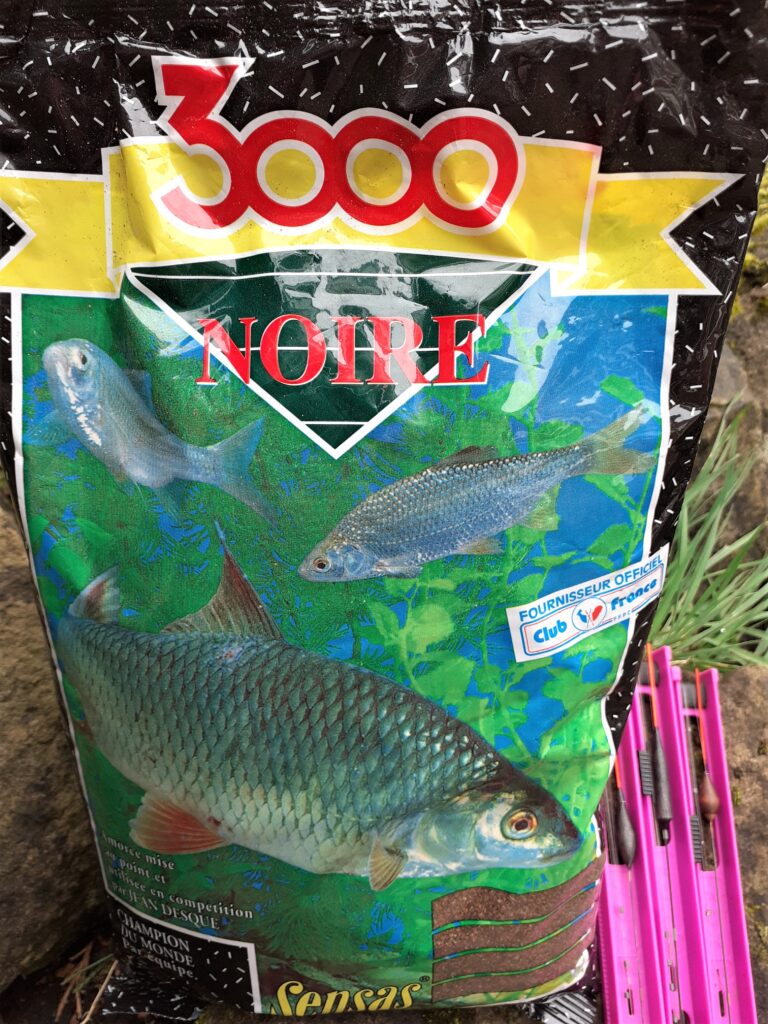
The moody looking packaging on Sensas Noire 3000 gives very little away as to what this dark brown groundbait is all about. It has been that way for many years. The only clue is the decent roach on the front. This is one of the best recipes for red fins I’ve ever had the pleasure to use. It has plenty of active hemp content and takes on a nice fresh bread/nutty aroma after mixing with water. I like to add in a small amount of brown crumb to fluff the consistency up a bit more, also some Sensas Black Lake to create extra fizz. I use this classic mix a lot in the winter when fishing cage feeders for big roach and hybrids, also all year round on the pole when fishing natural lakes, reservoirs, canals and drains. It often pulls in bream and skimmers when combined with chopped worm and casters. If this happens it’s worth adding a handful of brightly coloured micro pellets, which then gives you the option of trying soft 4mm or 6mm pellets on the hook over it.
ROBIN RED
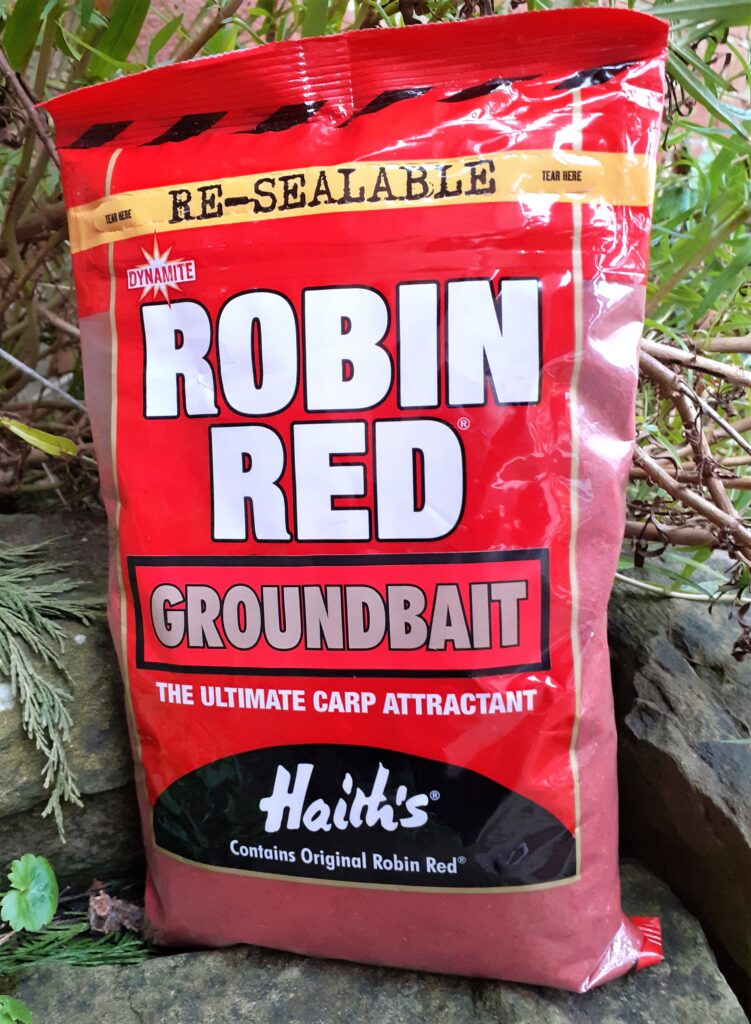
No fancy packaging to be found with Dynamite Baits’ Robin Red feed. Bright red stands out and that appears to be enough for both the bag and its contents. This is an unusual product that doesn’t bother saying much about what it does. All I could find is it contains original Robin Red, which results in a spicy, peppery aroma aimed at carp. But there is a small hint on the back of the bag that there might be more to this mix, showing a photo of an angler holding up a decent barbel. After experimenting I’ve discovered bream and tench like it a lot too. The acid test is using any mix as a paste, which quickly shows up the ones fish home in on and the duds that don’t pull any bites. This recipe worked great on a rudd-infested tench lake, using it as a soft paste on a big hook, over a bed of the same gear fed in loose form. It was good enough to work in its own right, plus now there are Robin Red Durable Hook Pellets, which are a perfect match.
WHAT WORKS
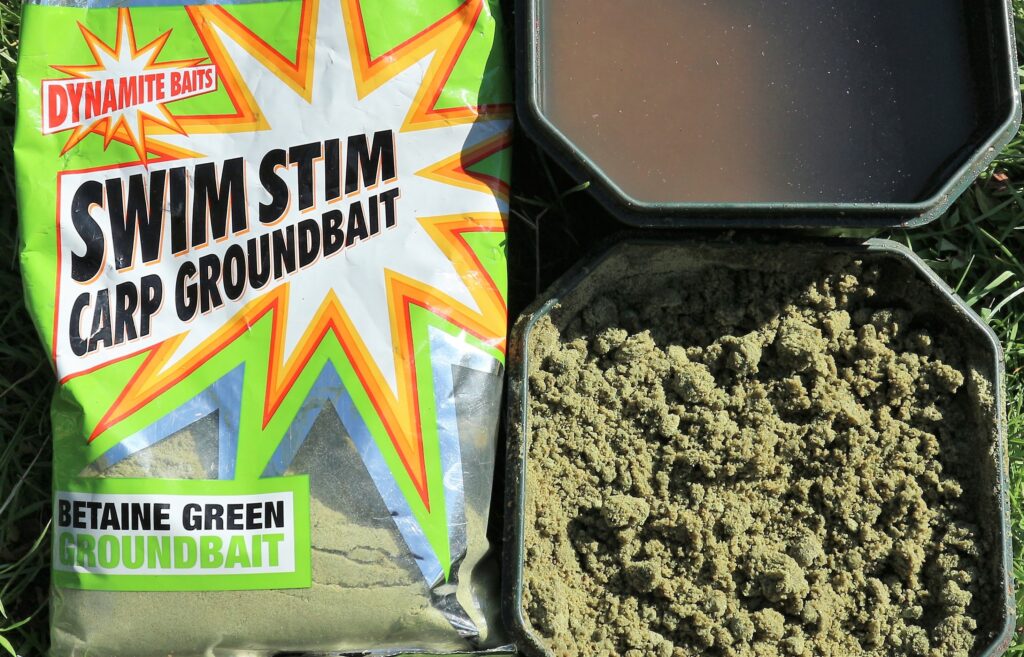
Swim Stim Betaine Green from Dynamite has been an iconic groundbait for many years, particularly noted for its pulling power when used as paste on carp-bagging venues. But I have also found this a brilliant recipe when I want a potent feed for tench and bream, particularly on hammered venues that have shut up shop to normal methods. I don’t meddle with this product, using it straight from the bag. One way is to cup it in loose and only slightly wetted, creating a thin carpet for fish to graze over. This works well for wary carp, with a good-sized ball of paste fished over the top. I have a bowl of water handy for forming hook baits, flicking a bit of extra moisture over the groundbait to make a stickier consistency. I often use a plastic bait spike for moulding the paste around, which allows a smaller, less obtrusive hook to be used. I mix this gear up more roughly for tench and bream, so there are plenty of lumps to hold their interest for longer.
SWEET STUFF
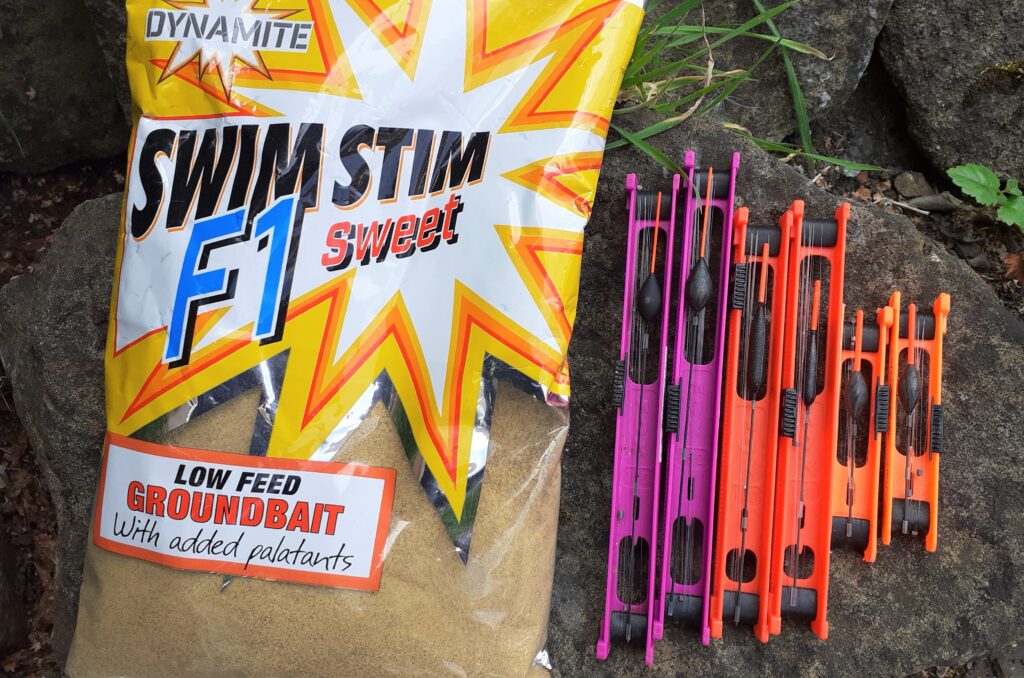
Most commercial fisheries are dominated by carp but also hold good stocks of silver fish. If I want to target the silvers, a favourite trick of mine is to use Dynamite’s Sweet F1 Groundbait, heavily laced with the same flavour 2mm pellets. There’s not too much fishmeal in this combination, which holds skimmers and bigger bream for ages, whether balling in, drip feeding, or using a feeder. Obviously, the product is primarily designed for F1 carp, but this hybrid species feeds in similar fashion to silver fish anyway. Apart from bream, sweet mixes like this can work for roach, crucians and rudd. A mix of the same flavoured groundbait and pellets is perfect for cage feeders. I find that sweet groundbait is more effective than strong fishmeal recipes in cold, wintry conditions. It doesn’t appear to fill fish up quickly and can be used as a carrier for introducing anything from pellets to naturals. A pal of mine uses F1 groundbait and micros on canals, which works a treat.
WILD SIDE
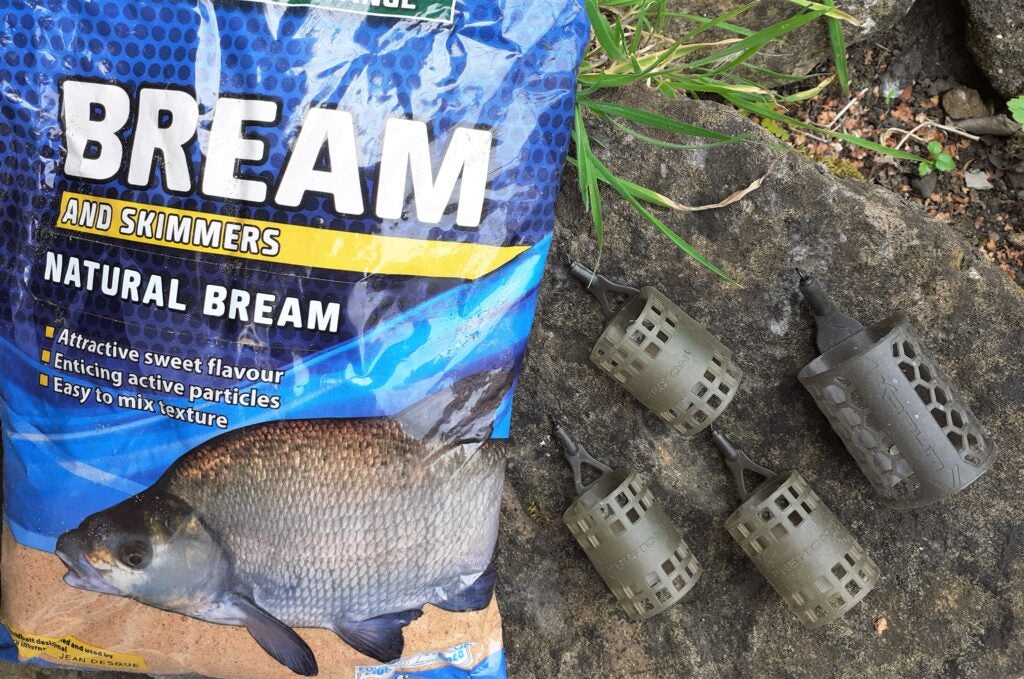
When targeting big bream on large lakes and reservoirs, one of my favourite feeder mixes is Sensas Natural Bream, but once again I modify this recipe by darkening it down with some Black Lake. The latter makes the groundbait a lot more active, so it quickly bursts out of both open-end and cage feeders. I also add some brown crumb as a bulking agent, finding 50% Natural Bream, 25% Black Lake and 25% brown crumb produces a superb consistency groundbait. Wild fish will graze over this for ages, whereas with fishmeal mixes I often find they drift away pretty quickly. I might add a few pellets if small fish are a problem with standard maggot, caster and worm feed. Low oil micro or 4mm pellets won’t feed off big slabs like super-strong fishmeal and pellet-based groundbaits seem to. I began using this favourite bream mix in Ireland many years ago, mainly with pole, groundbait feeder and slider tactics. It works a treat for slabs in the UK too.
CRUMB LOGIC
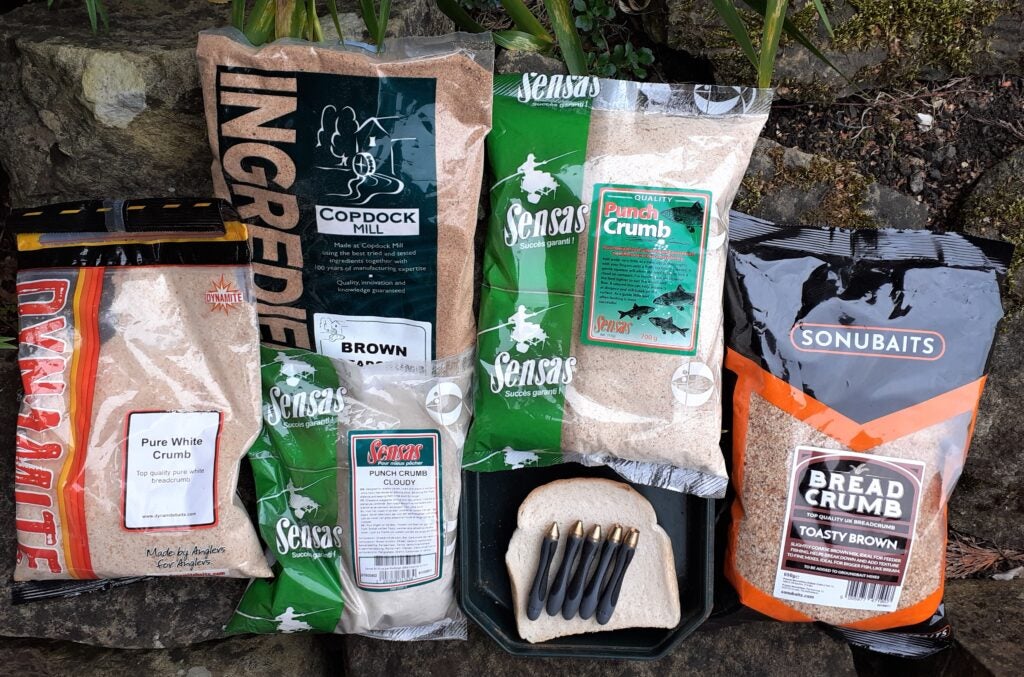
Although manufacturers probably don’t like it, I normally add some plain brown breadcrumb to most of the groundbait recipes I use, barring fishmeal ones being used as paste. Bulking groundbaits out makes them go further and tends to smooth their consistencies into something that’s easier to use. I only use white crumb for punch fishing, playing about with different types to get various effects, such as extra clouding for stillwaters, or better binding for river work. Punch crumb mixes up a lot better than plain white, which clogs easily. If I can’t get any punch crumb and have to make do with plain white feed, I add in a couple of handfuls of brown to loosen it up. I quite like a 50-50 mix of white and brown crumb anyway, which makes groundbait lighter, more active and possibly less filling. Plain brown crumb is okay for bulking fine to medium consistency groundbaits, but the bigger grain Toasty Brown from Sonu Baits is better for richer recipes.
The post Looking at Groundbait first appeared on FishingMagic Magazine.
Continue reading...

Dynamite is famous for its Frenzied range, which is built around ready-cooked hemp supplied in tins, along with the seeds in crushed form. Both are vital ingredients for many angler’s feeding requirements. Recent additions have seen worm and caster meal groundbaits introduced. They are easy to mix, fine in consistency, and super-rich in proteins and aminos. Due to a high ground hemp content, these are active recipes, mainly aimed at natural venues. The worm version is black, while the caster option is a dark brown colour. Both work extremely well in their own right, but are also good for darkening down and enriching other types of feeds. I’ve used these groundbaits extensively with pole, open-end and cage feeder tackle. They fizz and break down quickly if mixed neat or with crumb, slowing down with stiffer consistency mixes for deep or flowing water work. Explosive graphics on the packaging match the quality contents inside.
CONTINENTAL WAYS

Better groundbait recipes began to catch my attention several decades ago, when Continental mixes started appearing on the shelves in tackle shops. Up to that point groundbait packaging was on the dull side, but suddenly we had a new concept, with much more interesting names and eye-catching artwork. Sensas and Van Den Eynde products quickly became household names, giving us famous recipes like Super Cup, Secret, Turbo, Magic, Lake and Explosive. A new world opened up, where groundbaits were designed for different types of venues, species and methods. The trend continues to this day. I’ve made some good discoveries in the specialist brown range from Sensas. I particularly like Etang and Gardons, which are top silver fish groundbaits, ideal for whip or shallow fishing. You can mix these on the dry side or into a wet slop. They are perfect with some brown crumb added, quickly attracting roach, skimmers, perch, rudd and gudgeon.
GOING GREEN

Two mega-popular mixes are Bait-Tech Special “G” Green and Dynamite Betaine Green Milled Expanders. These rich recipes are hard to beat on commercial fisheries for targeting carp, but can’t be ignored when after bream or tench, even on natural venues. Both super-fine consistency feeds pull loads of bites when used as paste on the hook, which proves fish love the ingredients. All you need for a busy session is just one bag of either of these products, using them in roughly wetted form to attract and hold fish, flicking a bit of extra water over the mix to form balls of bait for the hook. I deliberately prepare these groundbaits in a slapdash manner, so they end up lumpy. The groundbait is then fed loose like this, which creates a nice bed of both fine particles and bigger pieces, so fish graze over the feed for long periods. Green is a surprisingly effective colour, particularly in the murky waters of busy, fish-packed venues.
SO NATURAL

Bait-Tech are masters of classy packaging with their popular groundbaits, none more so than with the Pro Natural range. Stylised images of the types of fish this recipe is designed to catch almost jump out at you from the bag. Rich ingredients like coconut, molasses, nuts and hemp are all in there, combined with a fast break down formula. This dark version is aimed at fishing clear waters and to work as a carrier for baits like maggots, casters, worms, pellets, hemp and sweetcorn. It’s a versatile recipe that can be balled in, catapulted, cupped, or used in various types of feeders. It covers lots of venues, species and methods. I would use this groundbait on waters I don’t know much about, when carefully feeling my way into sessions. A good choice when catapulting small, soft balls over waggler tackle, also for cage feeder and river applications, particularly when using groundbait with float tackle. Makes an excellent winter mix.
TECHNICAL STUFF

Sensas Carp Garlic Betaine is a green groundbait that wins my award for the most technical-looking packaging. I was also impressed with the description on the back. I quote, “A unique balance of dedicated attraction combined with a high-quality food source that together produce an intense and aggressive feeding response. The high level of water-soluble attractants will create a strong and positive canopy of feed signals that will encourage all fish to search and forage for the food item in a ravenous manner.” That sold the product to me! Along with the super-attractive bag of course! This interesting recipe works as a paste and groundbait for carp, requiring a second dose of water to bind properly. It pulled plenty of action when used with a method feeder, attracting both carp and bream on a mixed fishery. A quick go on a margin pole late on in the session revealed this green, smelly concoction pulls fish in quickly and creates plenty of action.
SPECIAL EFFECTS

Pro Feeder Groundbait from Bait-Tech stands out from the crowd on tackle shop shelves. Instead of fish images leaping at you, various feeder designs magically hover on the front of the packet. No need to worry about species and venues this gear is suited for; it tells you it will catch just about anything with fins and on all types of venue. My early impressions of this recipe are it can be mixed dry for an explosive consistency, or on the wet side if you want a dead, non-active groundbait. The natural light biscuit-smelling version turns golden brown after wetting, perfect for wild venues, while the dark fishmeal option suits commercial fishery feeder techniques. I was impressed on both fronts. As we all know, sweet groundbaits tend to work better on wild venues, while fishmeal content is often required on waters that see lots of carp action. The fishmeal version is also good for commercial fishery skimmers in winter, not being over-strong.
CLASSIC NOIRE

The moody looking packaging on Sensas Noire 3000 gives very little away as to what this dark brown groundbait is all about. It has been that way for many years. The only clue is the decent roach on the front. This is one of the best recipes for red fins I’ve ever had the pleasure to use. It has plenty of active hemp content and takes on a nice fresh bread/nutty aroma after mixing with water. I like to add in a small amount of brown crumb to fluff the consistency up a bit more, also some Sensas Black Lake to create extra fizz. I use this classic mix a lot in the winter when fishing cage feeders for big roach and hybrids, also all year round on the pole when fishing natural lakes, reservoirs, canals and drains. It often pulls in bream and skimmers when combined with chopped worm and casters. If this happens it’s worth adding a handful of brightly coloured micro pellets, which then gives you the option of trying soft 4mm or 6mm pellets on the hook over it.
ROBIN RED

No fancy packaging to be found with Dynamite Baits’ Robin Red feed. Bright red stands out and that appears to be enough for both the bag and its contents. This is an unusual product that doesn’t bother saying much about what it does. All I could find is it contains original Robin Red, which results in a spicy, peppery aroma aimed at carp. But there is a small hint on the back of the bag that there might be more to this mix, showing a photo of an angler holding up a decent barbel. After experimenting I’ve discovered bream and tench like it a lot too. The acid test is using any mix as a paste, which quickly shows up the ones fish home in on and the duds that don’t pull any bites. This recipe worked great on a rudd-infested tench lake, using it as a soft paste on a big hook, over a bed of the same gear fed in loose form. It was good enough to work in its own right, plus now there are Robin Red Durable Hook Pellets, which are a perfect match.
WHAT WORKS

Swim Stim Betaine Green from Dynamite has been an iconic groundbait for many years, particularly noted for its pulling power when used as paste on carp-bagging venues. But I have also found this a brilliant recipe when I want a potent feed for tench and bream, particularly on hammered venues that have shut up shop to normal methods. I don’t meddle with this product, using it straight from the bag. One way is to cup it in loose and only slightly wetted, creating a thin carpet for fish to graze over. This works well for wary carp, with a good-sized ball of paste fished over the top. I have a bowl of water handy for forming hook baits, flicking a bit of extra moisture over the groundbait to make a stickier consistency. I often use a plastic bait spike for moulding the paste around, which allows a smaller, less obtrusive hook to be used. I mix this gear up more roughly for tench and bream, so there are plenty of lumps to hold their interest for longer.
SWEET STUFF

Most commercial fisheries are dominated by carp but also hold good stocks of silver fish. If I want to target the silvers, a favourite trick of mine is to use Dynamite’s Sweet F1 Groundbait, heavily laced with the same flavour 2mm pellets. There’s not too much fishmeal in this combination, which holds skimmers and bigger bream for ages, whether balling in, drip feeding, or using a feeder. Obviously, the product is primarily designed for F1 carp, but this hybrid species feeds in similar fashion to silver fish anyway. Apart from bream, sweet mixes like this can work for roach, crucians and rudd. A mix of the same flavoured groundbait and pellets is perfect for cage feeders. I find that sweet groundbait is more effective than strong fishmeal recipes in cold, wintry conditions. It doesn’t appear to fill fish up quickly and can be used as a carrier for introducing anything from pellets to naturals. A pal of mine uses F1 groundbait and micros on canals, which works a treat.
WILD SIDE

When targeting big bream on large lakes and reservoirs, one of my favourite feeder mixes is Sensas Natural Bream, but once again I modify this recipe by darkening it down with some Black Lake. The latter makes the groundbait a lot more active, so it quickly bursts out of both open-end and cage feeders. I also add some brown crumb as a bulking agent, finding 50% Natural Bream, 25% Black Lake and 25% brown crumb produces a superb consistency groundbait. Wild fish will graze over this for ages, whereas with fishmeal mixes I often find they drift away pretty quickly. I might add a few pellets if small fish are a problem with standard maggot, caster and worm feed. Low oil micro or 4mm pellets won’t feed off big slabs like super-strong fishmeal and pellet-based groundbaits seem to. I began using this favourite bream mix in Ireland many years ago, mainly with pole, groundbait feeder and slider tactics. It works a treat for slabs in the UK too.
CRUMB LOGIC

Although manufacturers probably don’t like it, I normally add some plain brown breadcrumb to most of the groundbait recipes I use, barring fishmeal ones being used as paste. Bulking groundbaits out makes them go further and tends to smooth their consistencies into something that’s easier to use. I only use white crumb for punch fishing, playing about with different types to get various effects, such as extra clouding for stillwaters, or better binding for river work. Punch crumb mixes up a lot better than plain white, which clogs easily. If I can’t get any punch crumb and have to make do with plain white feed, I add in a couple of handfuls of brown to loosen it up. I quite like a 50-50 mix of white and brown crumb anyway, which makes groundbait lighter, more active and possibly less filling. Plain brown crumb is okay for bulking fine to medium consistency groundbaits, but the bigger grain Toasty Brown from Sonu Baits is better for richer recipes.
The post Looking at Groundbait first appeared on FishingMagic Magazine.
Continue reading...
